"A velvety mélange of fresh clams, sweet cream and even fresher corn off the cob, it is definitely more than a mere pottage. It is practically poetry." Bert Greene

It's a leftover dinner tonight - leftover soup in fact. A kind that I call corn chowder, mostly because it's got corn in it and also milk. I suppose this, in my ignorant way, is what I think of as chowder. Deep down I sort of knew that it wasn't - it was just a soup - but now that I have looked into chowder I sort of think that maybe I'm not so far from the authentic. Well if you take out the fact that the probably original chowders involved fish at least. So herewith a hybrid - Creamy corn and clam chowder with crispy chorizo from Andy Baraghani on the Bon Appétit website, which is at least American. That chorizo is not very authentic however, although I suppose it's a kind of bacon - but where are the biscuits?
On that student trip to America, Carole and I spent the first several weeks working in Woolworths in Philadelphia. There was a section of the store that served food and we got a discount, so, not having very much money - hardly any at all in fact - we would have a reasonably substantial lunch here, and I often had clam chowder. Now this was obviously mass-produced cafeteria style clam chowder but nevertheless I really liked it. And it was always served with salted crackers on the side, which I confess I thought was rather odd. Our experience eating in Greyhound bus terminal cafés and cheap diners, was the same. Soup was served with crackers not bread. More on the crackers, to come. Much later in life on a business trip to New Hampshire I was taken out for lunch and there I had the real deal. It was indeed 'practically poetry'.
"In the United States, it’s one of the few foods that’s both a cafeteria staple and a special-occasion meal. Atlas Obscura

According to Ann Ewbank on the Atlas Obscura website:
"the earliest known chowder was a winey, briny, bready casserole."
As shown here. They had a go at making it. And yes, it might be the first recipe for something called chowder, but honestly it is not the same dish at all, and probably does not even have the same origins.
Those origins are obscure and argued over, but they were definitely associated with the sea. The word's origins are variously thought to be from the French, 'chaudron' meaning a cauldron or the similar 'chodier' (Creole French) or 'chaudière' (Quebecois). Then there is the name of a fish soup from the north easter coastline of France called 'chaudrée'. The last one is the only one that has any connection to fish, however, the others merely denote a cooking pot so yes, that original recipe possibly has a more direct connection.
It's not all French however. There is also the Cornish word for a fishmonger - 'jowter'. And in spite of all of these suggestions the Oxford English Dictionary says it is American. Well that's the name, and the Americans of long ago New England probably did base the name of this particular soup on those French words for a big cooking pot.
As to the soup itself - the basic components seem to be fish or shellfish, salt pork or bacon, biscuits, potatoes and milk and/or cream. And so they think that the first versions were made by sailors voyaging to America from what they had on board, although that doesn't explain the milk, which must have been a later addition. I guess the potatoes and the biscuits - hard tack in the case of the sailors - would have made it lightish in colour - and thick.

The first versions - those on board the ships - would most likely have more often been fish rather than shellfish as well and apparently Julia Child's favourite fish chowder is an example, that the people of Food and Wine reproduced. On top of the dish are oyster crackers, although Food and Wine seem to have had a bet both ways, by including a baguette in the picture.
Today the Americans apparently use oyster crackers to thicken the soup, or to at least serve alongside. What are oyster crackers? Well small salted biscuits like the ones below, which are scattered on top of J. Kenji López-Alt's New England clam chowder. I don't know whether you can get quite the same thing here, as I don't often buy such thing, but maybe you can. This being a Serious Eats recipe he has gone into the exercise in immense detail to attempt to produce the ultimately authentic and perfect manifestation:
"The flavor of a clam chowder should be delicate and mild, the sweetness of the pork complementing the faint bitterness of the clams, accented by bits of celery and onion that have all but dissolved into the broth, fading completely into the background." J. Kenji López-Alt
As has Felicity Cloake of course, from a British perspective, though why she serves it in a cob loaf I have no idea. She also does a Perfect Cullen Skink which is a similar Scottish soup that features finnan haddie - smoked haddock and is similar in that it uses milk and cream. Cullen is a place, 'skink' - well they don't really know.
Nigel Slater also has a go - he actually has a few recipes - and summarises the archetypal clam chowder thus:
"The classic interpretation is to steam the well-scrubbed clams with a glass of water till they open, then chop the flesh. You fry the pork until the fat runs, then saute a little onion and some cubed potato in it, a few sprigs of thyme, then add milk, cream and the cooking liquor from the clams. It is as neat as that." Nigel Slater
Which in this house, besides the clams being a no no anyway, is a bit of a faff. He might have tried to make it sound simple but that first sentence contains a whole lot of work. Cooking clams any way seems to be a time-consuming process. Although I'm guessing that these days you can do a shortcut and buy already prepared clams. I shall never know.
Perhaps the greatest controversy over clam chowder is the Manhattan clam chowder. Well for a start Manhattan is not New England, but the real crime here is that it features tomatoes - oh the horror! The version shown here is from Melissa Gray of Food and Wine, and I would have to agree that it does not look at all like a chowder. It looks more like a Meterranean style fish soup. I also found Miso clam chowder from a man with a ridiculous name John Anderes Telegraph Chicago on the Bon Appétit website but it did look good.
To me a chowder is creamy - literally - with either milk or cream or a combination of the two. And it's thick. But it doesn't have to be clams, fish or any other kind of seafood. The Americans themselves seem to have evolved the initially fish, then shellfish versions into a corn version - which is what I always attempt to make. Maybe they turned to corn, when it moved from being an onboard seaman's dish to a home dish. The further the dish moved from the coast, the more likely it was that it would include less and less from the sea and I guess corn is the natural substitute for the fishy stuff. Cheap and available.

Once again J. Kenji López-Alt provides a Best corn chowder recipe and let me tell you it looks a whole lot better than mine. The version I made this time was too thin, and definitely not creamy enough. Also there was not enough corn in it and I left all of the vegetables whole, because David likes it that way. Tonight I think I shall take some of the whole vegetables out, blitz the bulk of the soup, return the whole vegetables, maybe adding a bit more corn, and cook it down to be a bit thicker. Maybe a bit of cream too. At least it will be a little bit different and therefore marginally less boring.
Corn chowder is easy to fiddle with however, and here are some of those fiddlings: Corn chilli chowder from Darren Robertson on the delicious. website - not terribly adventurous this one; Trini-inspired corn soup from Shiva Ramoutar in The Guardian which describes it as a chowder - there is coconut milk in this one and whole chunks of chilli but it looks gorgeous; Sweetcorn chowder with spiced butter from Ottolenghi - well he had to have a version didn't he? or you can also combine the seafood and the corn as is often done - the version by Diana Rattray of The Spruce Eats - Creamy corn and seafood chowder - is just one of many.
So a chowder is a relatively new - dating from the late seventeenth, early eighteenth centuries - but specifically American thing, that has evolved over time from a sailor's fish soup to a creamy soup that can be made with virtually anything - and the two lists that I found from Bon Appétit and Food and Wine - both American publications will give you a few more ideas. Well it's a soupy kind of day. After our touch of summer in the last few days we are back to wet, miserable and cold. I don't have any oyster crackers, or fresh bread, to accompany my soup so I'm trying to think of something to make to go alongside - savoury scones, cornbread, damper ...
TWO POSTSCRIPTS

Scotch eggs.
Wendy, one of my loyal readers, mentioned Scotch eggs for yesterdays post on Scottish food. And I did mean to mention them but only because they are not Scottish. They wouldn't be called Scotch eggs if they were. They would be Scottish eggs.
Wikipedia has several different 'origin' stories. A combination of Maria Rundell and Mrs. Beeton who added the breadcrumb layer. Fish paste instead of sausage meat originally. Yorkshire. 'Scorch' eggs because originally they were cooked over a fire, although most seem to think they were deep-fried in lard. Or during the 19th century trade in eggs from Scotland the eggs were sometimes dipped in lime powder to preserve them and this was called 'scotching'. I think sometime long ago I wrote about Scotch eggs. But yes, I did mean to mention them yesterday. Scotch broth though does seem to be Scottish - so go figure.
Nigel's lamb chops with apricots and focaccia
A moderate success only. David didn't like the apricots but the sauce did very satisfactorily sink into the toasted focaccia. It was one of those dishes with an undefinable but satisfying taste but nothing sensational. It was, however, supremely easy. Would I do it again? Probably not. You win some you lose some, although 'lose' is somewhat over dramatic. Just not sensational. There are so many other things to try. Lamb is so expensive anyway - well lamb chops. Apologies the photographs are not very good.




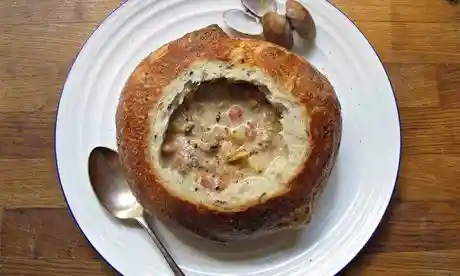



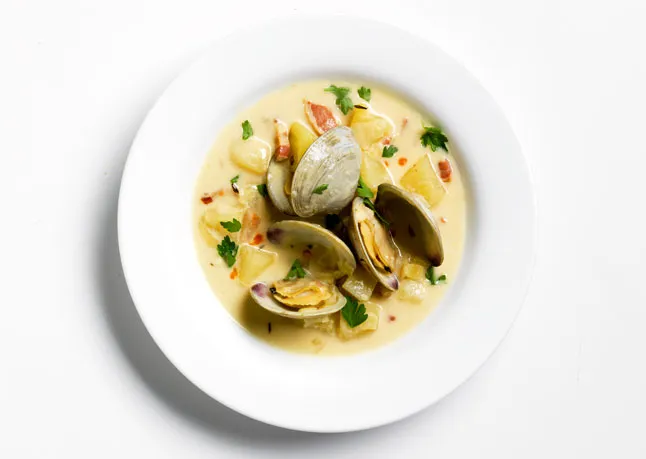


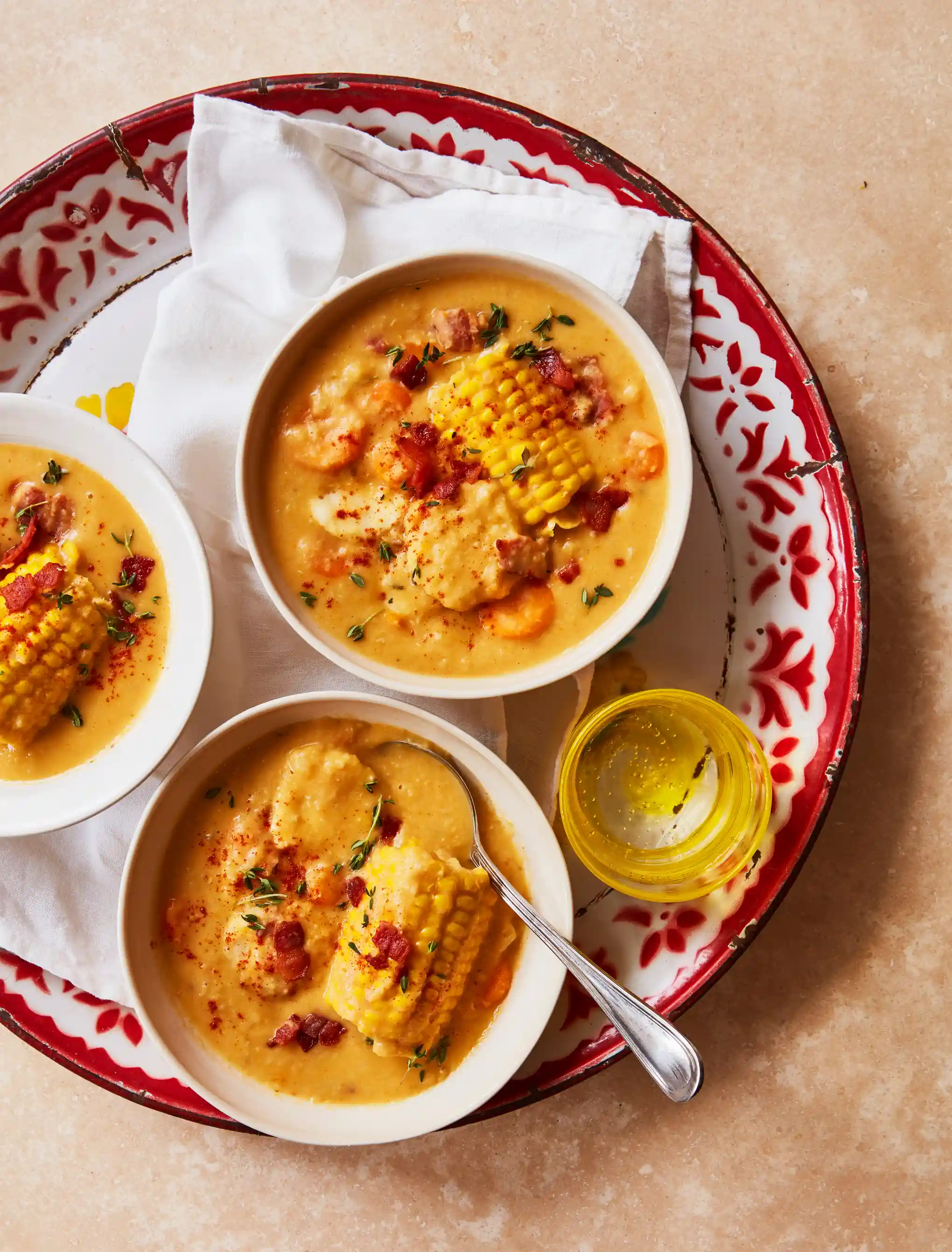
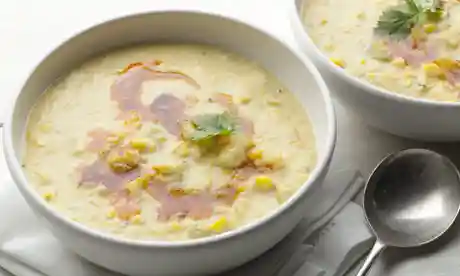





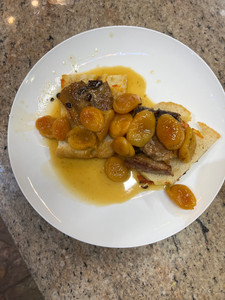
Comments